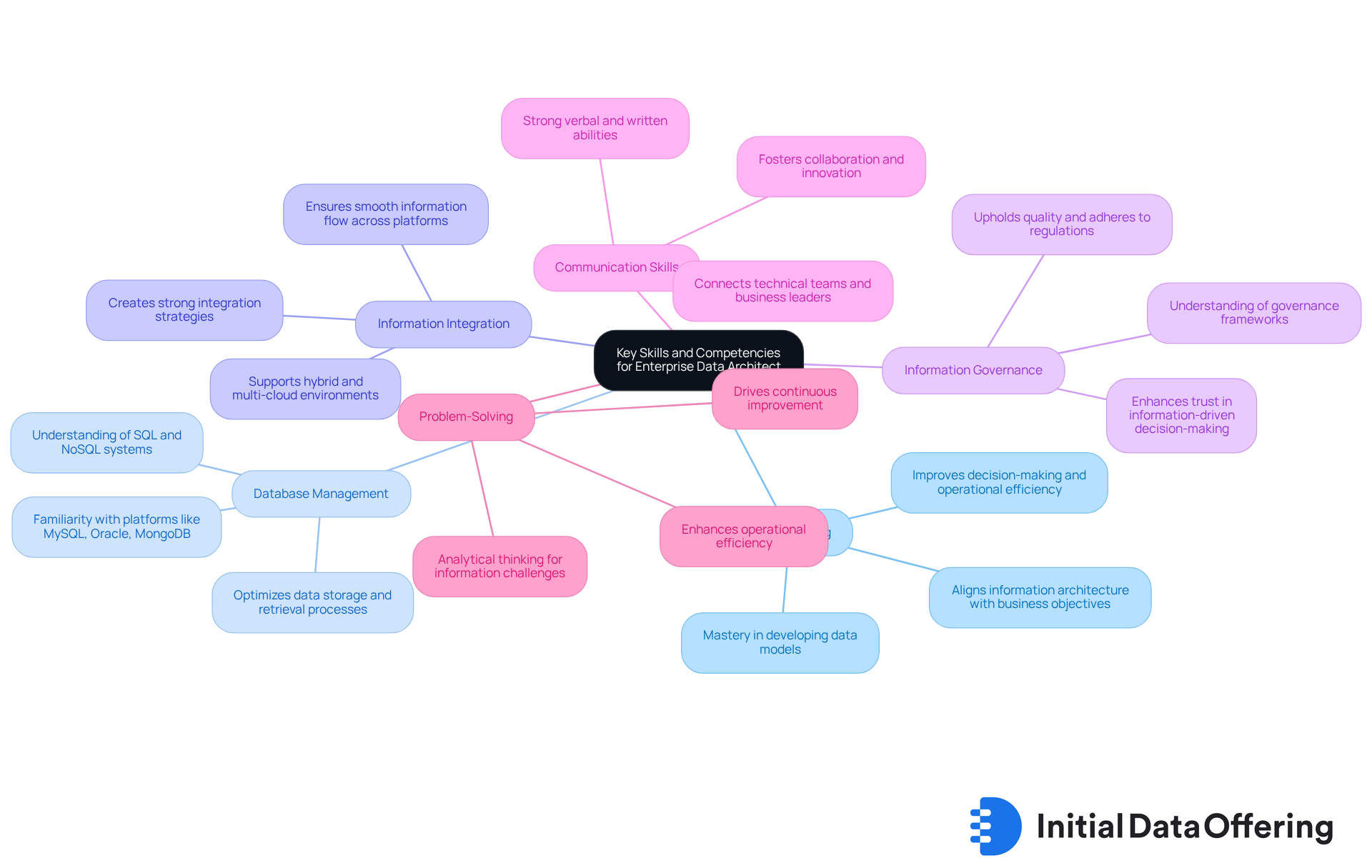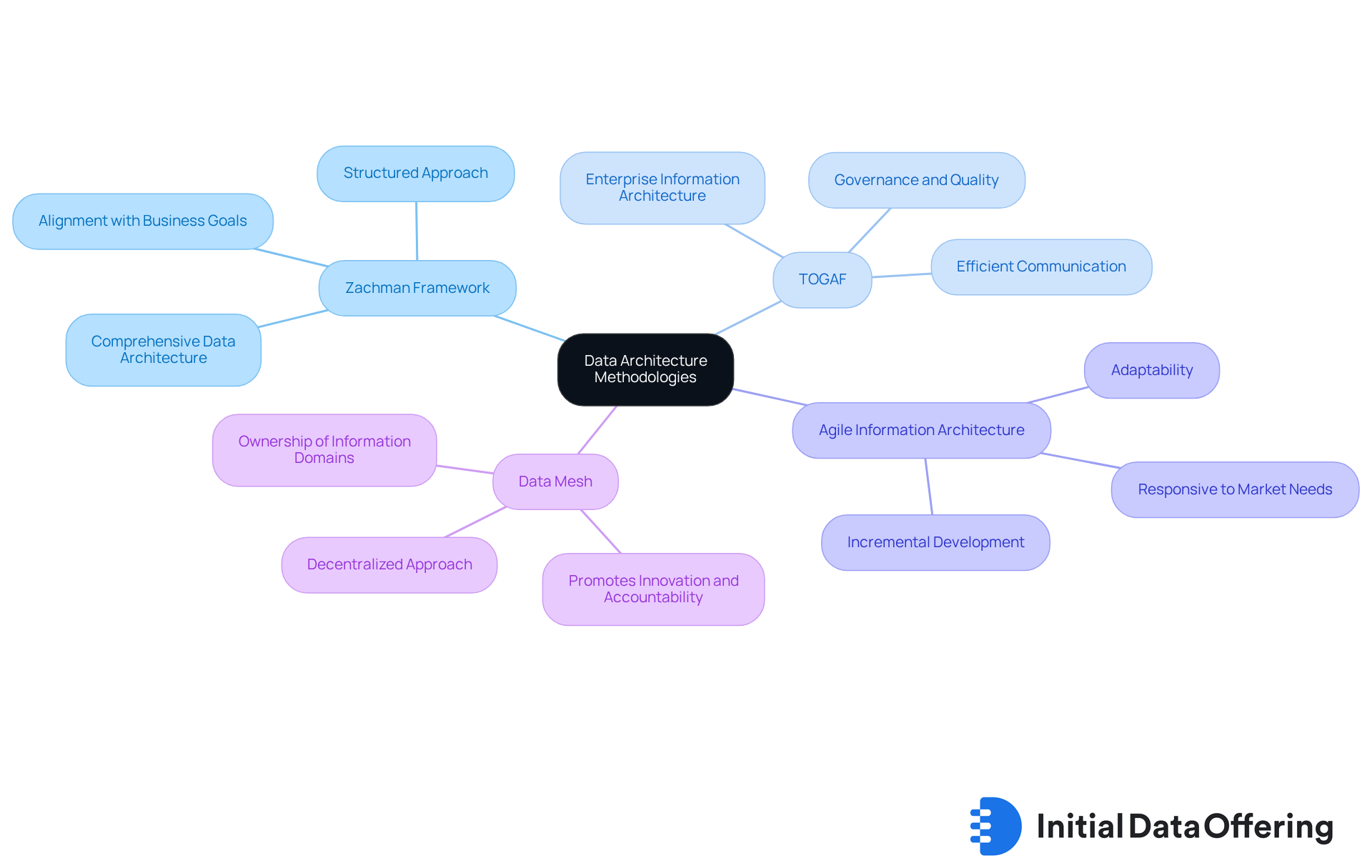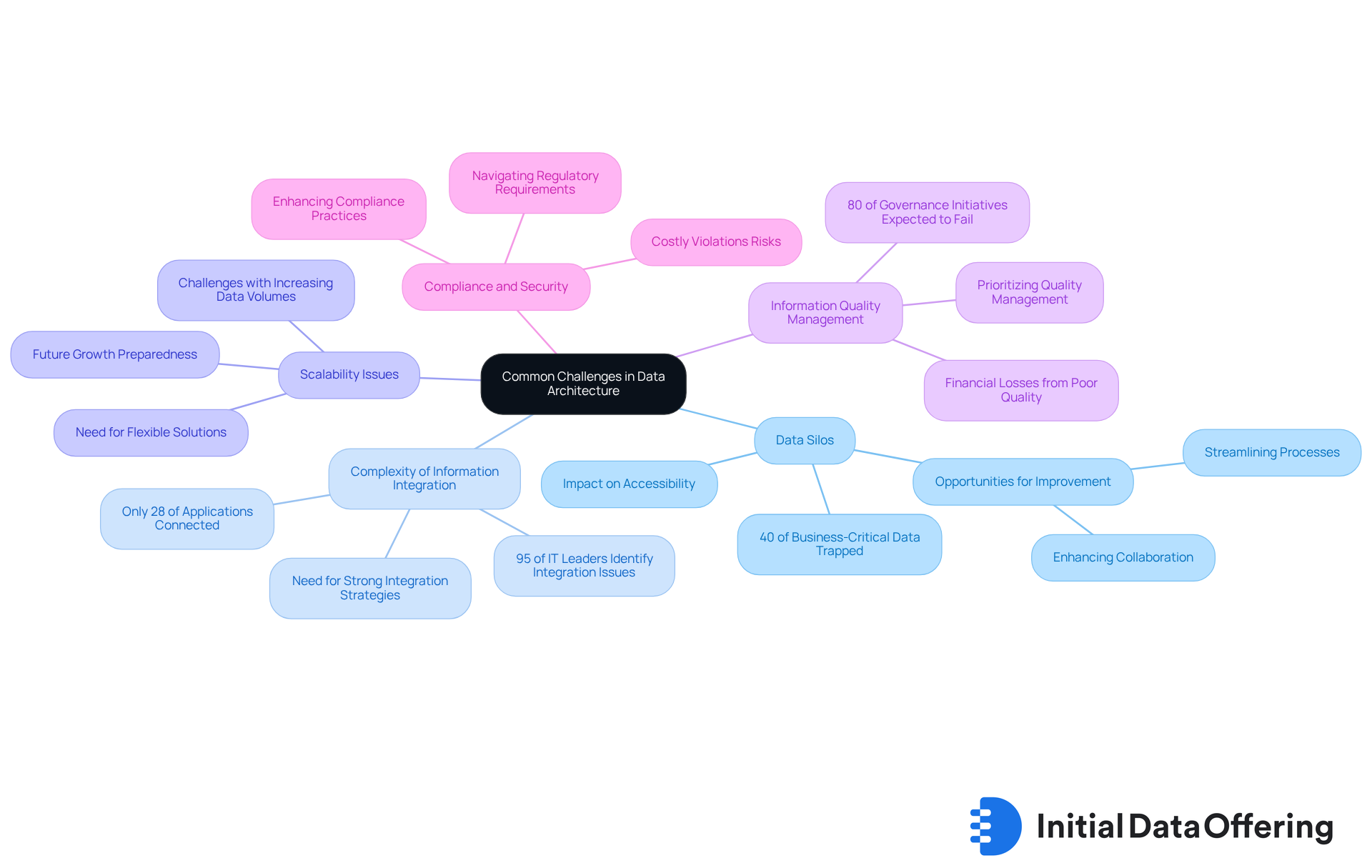Mastering the Role of an Enterprise Data Architect: Skills and Strategies

Mastering the Role of an Enterprise Data Architect: Skills and Strategies
Introduction
The role of an enterprise data architect is increasingly vital as organizations seek to leverage information in a fast-changing digital landscape. This position is pivotal because it allows professionals to align data strategies with business objectives, ensuring that information becomes a dependable asset for decision-making. However, as the need for skilled architects rises, so do the complexities surrounding data governance, integration, and quality management.
How can organizations effectively navigate these challenges to fully utilize their data architecture? By addressing these complexities, businesses can unlock the true potential of their data, transforming it into a strategic advantage. This not only enhances decision-making but also fosters innovation and growth in an ever-evolving market.
Define the Role of an Enterprise Data Architect
An enterprise data architect plays a pivotal role in shaping and managing an organization's information infrastructure. This position ensures that information is accurate, accessible, and secure across various systems, serving as the foundation for managing information assets. By aligning information architecture with overarching business objectives, the architect facilitates robust governance.
What are the key responsibilities? Responsibilities include defining information standards, creating comprehensive models, and overseeing the integration of emerging technologies into existing frameworks. By developing a unified information strategy, organizations can utilize information effectively with the help of an enterprise data architect. This fosters informed decision-making and enhances operational efficiency.
Why is this role crucial in 2025? The importance of information structure is underscored by the fact that organizations with a strong information governance foundation can confidently implement AI. Yet, fewer than half of companies currently appreciate the value of information for decision-making. As industry leaders highlight, the role of the enterprise data architect is evolving. It now encompasses not only technical proficiency but also strategic alignment with business objectives, ensuring that information acts as a vital asset in navigating complex market dynamics.
This shift indicates a broader trend where successful enterprise information architecture implementations are increasingly recognized as essential for promoting a knowledge-driven culture. Ultimately, this leads to a competitive edge in the marketplace. How can your organization leverage the expertise of an Enterprise Data Architect to enhance its information governance and decision-making processes?

Identify Key Skills and Competencies
Key skills and competencies for an enterprise data architect in 2025 encompass a range of technical and interpersonal abilities essential for navigating the evolving data landscape.
-
Data Modeling: Mastery in developing data models that accurately reflect business processes and data flows is crucial. This skill allows architects to design a cohesive structure that facilitates efficient information management and analysis. As Doug Laney observes, comprehending the subtleties of information modeling is essential for aligning information architecture with business objectives. The advantage here is that effective data modeling leads to better decision-making and operational efficiency, ultimately benefiting the organization.
-
Database Management: A deep understanding of various database technologies, including both SQL and NoSQL systems, is vital. Familiarity with platforms like MySQL, Oracle, and MongoDB enables architects to choose the right tools for specific organizational needs. This is becoming increasingly important as entities face challenges in managing diverse information environments. The benefit of this knowledge is that it empowers organizations to optimize their data storage and retrieval processes, enhancing overall productivity.
-
Information Integration: The capacity to create and execute strong information integration strategies guarantees smooth information flow across various platforms. This competency is becoming more essential as companies adopt hybrid and multi-cloud environments. According to a statistic, 80% of digital organizations will fail because they don't adopt a contemporary approach to information governance, emphasizing the significance of integration in governance frameworks. By mastering this skill, architects can ensure that data is accessible and actionable, leading to improved business outcomes.
-
Information Governance: Understanding information governance frameworks is crucial for upholding quality and adhering to regulations such as GDPR and HIPAA. Effective governance practices improve integrity, accuracy, and consistency, fostering trust in information-driven decision-making. As pointed out by Veda Bawo, high-quality information is essential for effective governance. This understanding not only mitigates risks but also enhances the organization's reputation and compliance posture.
-
Communication Skills: Strong verbal and written communication abilities are essential for working with stakeholders and presenting intricate information concepts in an accessible manner. This competency aids in connecting technical teams and business leaders, a point stressed by Dr. Jennifer Priestley, who underscores the necessity for professionals to merge technical and business insight. The advantage of effective communication is that it bridges gaps between teams, fostering collaboration and innovation.
-
Problem-Solving: Analytical thinking and problem-solving abilities are essential for tackling information-related challenges and enhancing information architecture. Information architects must be skilled at recognizing issues and applying effective solutions to improve management practices. This skill not only enhances operational efficiency but also drives continuous improvement within the organization.
Current trends indicate that successful architects are also emphasizing continuous learning and adaptability, as the demand for skilled professionals in management continues to grow. For example, entities such as JPMorgan Chase have effectively adopted mesh structures to decentralize ownership and enhance accessibility, demonstrating the influence of creative information modeling strategies. As the field progresses, remaining informed about advancements in information technologies and methodologies will be essential for succeeding as an enterprise data architect.

Explore Data Architecture Methodologies and Best Practices
Information structure approaches and optimal techniques are essential for organizations aiming to enhance their information management strategies. Here are some key frameworks:
- The Zachman Framework: This structured approach provides a comprehensive view of an organization's data architecture. It addresses various perspectives to ensure alignment with business goals, making it a vital tool for effective information management.
- TOGAF (The Open Group Architecture Framework): TOGAF plays a crucial role in designing, planning, implementing, and governing enterprise information architecture. Its organized approach fosters efficient communication and collaboration among teams, ultimately improving information governance and quality.
- Agile Information Architecture: This method emphasizes adaptability and incremental development, enabling organizations to swiftly adjust to evolving information needs and market conditions.
- Data Mesh: A decentralized approach that treats information as a product, Data Mesh encourages cross-functional teams to take ownership of their information domains, promoting innovation and accountability.
Current best practices in information architecture underscore the importance of regular audits, clear governance policies, and the need for scalability and security within information systems. Statistics indicate that organizations adopting these practices can significantly enhance their information accessibility and decision-making capabilities. For instance, those implementing a robust information governance framework can reduce information-related risks and improve compliance, leading to better business outcomes. Notably, individuals spend 60% to 80% of their time searching for information, highlighting the urgent need for efficient information management strategies.
Thought leaders in the field emphasize the necessity of these methodologies. Geoffrey Moore aptly states, "Without large information, you are blind and deaf and in the middle of a freeway," illustrating the critical role of information in informed decision-making. Clive Humby also points out, "Information is the new oil," reinforcing its value in today’s data-driven landscape. The advantages of TOGAF for enterprise data architects in enterprise information structures are evident; it not only simplifies processes but also aligns information initiatives with strategic goals, paving the way for successful information-driven transformations in 2025 and beyond. To fully leverage these methodologies, organizations must also address challenges related to outdated information infrastructure.

Address Common Challenges in Data Architecture
Common challenges in data architecture include:
-
Data Silos: Isolated data pockets significantly hinder accessibility and integration across departments. Approximately 40% of business-critical information remains trapped in these silos, leading to inefficiencies and missed opportunities. Organizations that successfully break down these barriers can enhance collaboration and streamline processes, ultimately improving decision-making and operational efficiency. How might your organization benefit from addressing these silos?
-
Complexity of Information Integration: Combining information from various sources presents substantial difficulties, resulting in inconsistencies and inefficiencies. A staggering 95% of IT leaders identify integration issues as a primary barrier to AI adoption, with only 28% of enterprise applications currently connected. This gap highlights the necessity for strong information integration strategies to ensure smooth flow across platforms. What strategies could you implement to improve integration in your organization?
-
Scalability Issues: As information volumes and user demands increase, organizations encounter difficulties in expanding their architecture effectively. The swift rise in information generation necessitates flexible solutions that can adjust to evolving needs without compromising performance. Are your current systems equipped to handle future growth?
-
Information Quality Management: Ensuring information accuracy and reliability is essential, particularly during ongoing changes and updates. Poor information quality can result in substantial financial losses, with 80% of information governance initiatives expected to fail without appropriate management frameworks established. How can your organization prioritize quality management to mitigate these risks?
-
Compliance and Security: Navigating regulatory requirements while implementing robust security measures to protect sensitive information is a persistent challenge. Organizations must ensure that their information management practices comply with regulations to avoid costly violations and maintain customer trust. What steps can you take to enhance compliance and security in your data architecture?
To tackle these challenges, organizations can adopt strategies such as implementing Unified Management (UDM) systems, which integrate governance, quality, and mobility, thereby enhancing accessibility and compliance. Additionally, leveraging data integration tools can facilitate the extraction, transformation, and loading of data from various sources, creating a unified view that supports informed decision-making. By addressing these challenges head-on, organizations can position themselves for greater success in the data-driven landscape.

Conclusion
An enterprise data architect plays a crucial role in shaping an organization's information landscape, ensuring that data is leveraged as a strategic asset aligned with business objectives. This position has evolved to require not just technical expertise but also a strong focus on governance and strategic alignment. For organizations aiming to thrive in an increasingly data-driven world, this role is indispensable.
Key responsibilities of an enterprise data architect include:
- Data modeling
- Database management
- Information integration
- Governance
These features are essential for creating a cohesive data strategy. Moreover, soft skills such as communication and problem-solving are vital, bridging the gap between technical teams and business stakeholders. By emphasizing these skills, organizations can enhance collaboration and drive better outcomes. Various methodologies and best practices have also been discussed, highlighting the importance of a structured approach to tackle common challenges like data silos, integration complexities, and compliance issues.
As organizations navigate the complexities of modern information architecture, the role of the enterprise data architect becomes increasingly critical. Embracing the necessary skills and methodologies not only enhances information governance but also empowers organizations to make informed decisions that drive success. By prioritizing these strategies, businesses can harness the full potential of their data, ensuring they remain competitive in a rapidly evolving landscape. How can your organization leverage the insights from this role to improve its data strategy?
Frequently Asked Questions
What is the role of an enterprise data architect?
An enterprise data architect is responsible for shaping and managing an organization's information infrastructure, ensuring that information is accurate, accessible, and secure across various systems. This role serves as the foundation for managing information assets and aligns information architecture with business objectives to facilitate robust governance.
What are the key responsibilities of an enterprise data architect?
Key responsibilities include defining information standards, creating comprehensive models, overseeing the integration of emerging technologies into existing frameworks, and developing a unified information strategy to enhance effective information utilization.
Why is the role of an enterprise data architect crucial in 2025?
The role is crucial because organizations with a strong information governance foundation can confidently implement AI. However, fewer than half of companies recognize the value of information for decision-making. The evolving role now requires not only technical skills but also strategic alignment with business objectives, making information a vital asset in complex market dynamics.
How does an enterprise data architect contribute to decision-making processes?
By developing a unified information strategy and ensuring effective governance, an enterprise data architect fosters informed decision-making and enhances operational efficiency within the organization.
What broader trend is indicated by the evolving role of the enterprise data architect?
The trend indicates that successful implementations of enterprise information architecture are increasingly recognized as essential for promoting a knowledge-driven culture, which ultimately leads to a competitive edge in the marketplace.